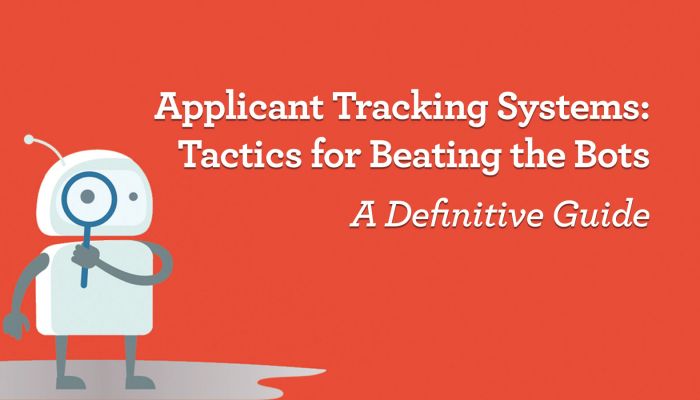Hiring managers, HR pros, and recruiters love applicant tracking systems (ATS) — software applications that, among other things, sift through reams of resumes, plucking out the most suitable for the job.
The ATS automates parts of the hiring process, which is very good news for busy recruiters. One reason for the rise in the use of ATS is the ease of applying for jobs online. When you’re out of work, there’s a temptation to apply online for jobs that you might not be completely qualified for — just on the off-chance something on your resume catches the hirer’s eye. That’s a common tactic for job seekers and a headache for HR pros, who can find themselves flooded with resumes from applicants that don’t have the skills and experience for the job. Hence the popularity of ATS, which automate the process of winnowing down candidates to the top few.
So, ATS are great for hirers. For job seekers? Not so much. You can find yourself sorted and sifted right out of a job by the “bots,” a human being never seeing your resume. And, let’s talk about those bots for a minute. There are algorithms to this madness, keywords that must appear on your resume that flag the ATS to put you in the “interview” pile. How do you know what, exactly, to include on your resume?
If it feels like the process of job hunting has been completely redefined, that’s because it has been. Today, it’s up to savvy job hunters to learn the new rules of the road, understand how to outsmart the bots, get their resumes into the hands of human beings, and win at this new ballgame.
In this blog, we’ll give you the facts about ATS and tactics you can use to find the job of your dreams.
Facts about ATS that you might not know
FACT: According to Jobscan, 98% of Fortune 500 companies use ATS
There’s no getting around it. The vast majority of large companies use some type of applicant tracking system and SMBs are following suit. Expect to encounter these throughout your job search.
FACT: 70% of resumes are not seen by employers. Ever.
Big companies get thousands of resumes each week (a reported 50,000 per week for Microsoft and 75,000 per week for Google). There’s no time for a human to go through each one. The ATS cuts approximately 70% that don’t match the required criteria.
FACT: Rare keywords are your secret weapons in beating the bots.
To get a top-ranking resume you not only need a high quantity of keywords, but you also need high-quality keywords. Some keywords are weighed more than others, and resumes that include these will instantly stand out. Hint: Look at the job description and interviewer’s LinkedIn profile for clues.
FACT: Resume length doesn’t matter.
Computer software doesn’t care if your resume is one page or five. While you can be a bit more liberal when developing copy, keep in mind the ultimate goal is for your resume to reach a human eye. If the length is ridiculous, it will get thrown out. Find the sweet spot to appease both man and machine.
FACT: Abbreviations are a no-no. They can get missed.
Abbreviations can be missed if they are not programmed into the ATS, so play it safe by spelling out words completely. Use popular industry acronyms but spell out the words in parenthesis afterward to make sure your information gets pulled and ranked appropriately.
FACT: ATS save companies time and money.
Yes, Fortune 500 companies are using ATS, but they can be even more of a boon to small businesses. Using an ATS for hiring can save a small company with just eight employees $10,000 in wasted time and effort. For big companies, the savings are much more. That money motivation means the ATS is only going to become more prominent.
Now that you have some basic facts, let’s look a little deeper into ATS.
Spotting the bots
Before you can learn how to beat the bots, you first need to know how to spot them. Here are some clues you’re dealing with an ATS:
Clue 1: Online forms
You see a job of interest and you click on the “apply now” button. You are then instructed to go through various pages of online forms. It can be time-consuming to type your information in each section, but it’s a necessary step. All the information you fill out in online forms is likely to be parsed out and sorted by the ATS.
Clue 2: Complicated URL
When you’re filling out an application, is there a lot of gobbledygook in the URL at the top of the browser? There may be numbers, categories, locations, and other coding inclusions. This is an indication you’re working with an ATS. You may even see the name of the ATS the company uses in the URL, such as Jobvite or Taleo, two popular systems.
Clue 3: Company size
The majority of Fortune 500 companies use an ATS of some kind. Not doing so presents a logistical nightmare of managing an overwhelming flow of resumes for a large number of open jobs. The larger the company receiving your resume, the more likely you’ll be forced to use an ATS. The startup with five employees may not need one quite yet.
These three simple clues let you know that you need to be particularly careful about the words and phrases you use in your application to ensure you can move one step closer to scoring an interview.
How the top 5 ATS read resumes differently
We recently ran a blog written by Paige Doepke about how different ATS read resumes differently. Highly useful, insider information for a job seeker.
After spending hours filling out forms and uploading documents, well-qualified applicants are left wondering why they’re not being interviewed for jobs they consider attainable.
The reason isn’t necessarily the person; rather, it’s the information supplied. An ATS works by pulling resumes that contain a variety of important terms. The terms are selected by the recruiter or hiring manager who is tasked with filling the position. If your resume doesn’t contain the right keywords — or enough of them — you’ll end up in a virtual black hole.
To make things even more tricky, each ATS actually reads resumes in a slightly different way.

If given the opportunity, an applicant can increase their chances of getting past the resume screener by catering their resume to the specific ATS. For example, if the ATS being used does not parse plural forms of keywords correctly, the applicant should pay special attention to keywords before submitting his or her resume.
For a better understanding, here’s a look into how the top five ATS read resumes differently.
Taleo
Taleo, the most popular applicant tracking system powered by Oracle, allows recruiters and hiring managers to search the database by the applicant’s location. While searching by location is pretty standard among ATS, Taleo is unique in that it uses zip codes specifically.
What does this mean for job seekers? While the use of full addresses has become passé, you may want to consider city and state followed by zip code, if you want to be sure to pass the geography test.
Greenhouse
Greenhouse is used by many major companies, including Airbnb and Pinterest. This ATS reads resumes differently than others by looking to fill in three specific categories for each job listed: company name, position title, and dates of employment, in that order.
It is good practice as a job seeker to include the full company name, position title, and dates of employment (including month and year) in order to have all information properly parsed into his or her applicant profile.
iCIMS
iCIMS, like Taleo, sets itself apart by location search. However, this ATS makes location searchable by city name rather than zip code.
In order for a resume to be suitable for all types of ATS, include both city name and zip code.
BambooHR
This ATS does not allow hiring managers to search by keyword to the same extent many others do, which means recruiters will likely read through applicants’ resumes the old-fashioned way.
For this reason, readability is more important than formatting when submitting through BambooHR. If you’re unsure of the ATS being used, put equal emphasis on readability and formatting. After all, the goal is for a hiring manager to read the resume eventually.
Jobvite
Jobvite, used by LinkedIn, Hulu, and Logitech, is one of several ATS that prefers non-abbreviated keywords. For example, if the applicant is an SEO expert, Jobvite might prefer “Search Engine Optimization Expert” instead. When in doubt, applicants should use both the unabbreviated version and the acronym. In this case, it would be acceptable to use “Search Engine Optimization (SEO) Expert.”
It will not always be made clear on a job application form which applicant tracking system is being used. In cases when it is not clear, job seekers should err on the side of caution by catering to the differences between top ATS. For example, a resume that includes zip code, city name, full dates of employment, impressive readability, and unabbreviated keywords will get through many ATS roadblocks.
One more ATS-specific tip
With Jobscan, job seekers can analyze their resume against a specific job description to learn which search keywords they’re missing as well as bonus tips based on which ATS they’re using.
Optimize your resume for ATS
Now that you know the quirks and preferences of the different ATS out there, it’s time to get down to the nitty-gritty with your resume.
Here are a few places to start:
Keywords. First, start by creating a list of important keywords used in your industry. For ideas, check out LinkedIn to review colleagues’ profiles as well as people who hold a position similar to what you’re going for. Remember, keywords are the most important step in getting past the ATS filters, but you still must write with a person in mind. Keyword-stuffing may get your application flagged. Worse, if your resume makes it to a human eye, it will be difficult to read and comprehend, which will eliminate you from the running.
Job descriptions. This copy is rich with keywords that are useful to include in your resume and application. Look for terms and words common across different descriptions and be sure to stress those when possible.
Phrasing choices. Because no technology is perfect, and as we’ve learned different ATS read resumes differently, phrasing choices can be confusing. For example, an ATS may not be able to distinguish between Master of Business Administration, Master’s degree in Business Administration, and MBA. You would never list all three, so what should you do?
For all cases where there is a shortened acronym or a term, try to include both. For instance: Master of Business Administration (MBA). For other questions and concerns, always reference the job description. It’s likely that the terms used in that copy are the same ones programmed into the ATS. Customize your resume to reflect these words and phrases exactly.
Keep it simple. Beyond keywords, there are a few additional steps to help you optimize your resume. Strive to keep things simple in regard to formatting and order. Graphics and charts cannot be comprehended, so skip them completely. Keep headings standard because creative alternatives may get dismissed.
The ATS is not the job hunter’s arch nemesis. In fact, if you understand how these systems work, you can bend the odds in your favor with strategic phrasing and resume design. Just remember to do your research and customize each application. Then you’ll be getting a call back before you know it.
More do’s and don’ts on beating the bots

Consider this: You have the perfect skill set for a job and submit your application. You wait and hear nothing. Eventually you get a canned rejection letter. Why? You probably weren’t flagged by the ATS. If you can’t make it past the “bot” you won’t ever make it to a human eye.
The frustration that follows can be difficult. In fact, industry insiders are using the term “Algoriphobia” to classify applicants’ fear that keyword-based algorithms will always favor other applicants.
What can you do when you feel like you just can’t win? You try something new.
The key is to create an application that the software loves. To do this you should follow these best practices for beating the ATS so you can land an interview and ultimately get the job you really want.
1. Do Utilize the Job Description
Be keyword savvy. Use language from the job description within your resume. It’s likely that the person who programmed the ATS entered similar verbiage.
2. Do Research Industry Keywords
Use industry-specific keywords throughout your resume. Need ideas? Research the company website or the LinkedIn profiles of current employees. Trends will emerge, so write them down and add them into your copy.
3. Do Include and Write Out Acronyms
Acronym uncertainty? When you’re unsure about how an important term should be referenced, consider writing out the phrase and then use the acronym in parentheses afterward. That way, you are covered no matter what the system is flagging.
4. Do Submit a PDF
Submit a PDF unless the application process says otherwise. PDFs will lock in your formatting so that everyone will see your resume just as you see it. Word docs are not as reliable. Using a PDF solves other concerns as well, such as headers, footers, and graphics. Keep in mind that the text within a graphical image is not readable, but the graphic is unlikely to interfere with the resume parsing process.
5. Do Bold and Underline
Use bolding and/or underlining to highlight key words or phrases. This type of formatting is also great for organizing a resume. This will not bother the ATS and can help when an actual person is viewing your resume.
6. Do Stick to Standard Language
Skip creative wording. The system won’t recognize it. Coining new terms and adding colorful language has no value to an ATS. Save that for the interview.
7. Do Add Location Information
You do not need to include your precise postal address. But, since the system is likely looking for a geographic match, be sure to include some location information. If you live just outside a big city, the city name and state is just fine. It’s similar to how your LinkedIn profile might say Greater Chicago area, not the specific suburb you live in.
8. Do Go Long
Length doesn’t matter to the ATS, so longer resumes are generally appropriate. No need to worry about sticking to one or two pages.
If you still have problems getting past the ATS or are starting to suffer from a case of Algoriphobia, consider working with an expert career coach who can guide you to success.
At GetFive, that’s part of what we do. We’ll be happy to help you make sure your resume can beat the bots and get into the hands of a hiring manager.









